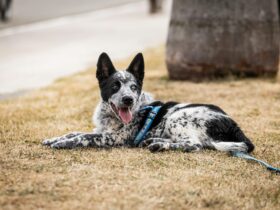Introduction
Walking your dog is more than just a routine task—it’s an essential part of their physical and mental well-being. But how often should you walk your dog? The answer isn’t one-size-fits-all, as it depends on various factors like breed, age, health, and energy levels. In this guide, we’ll explore how often you should walk your dog, signs that your dog may need more exercise, and tips for creating the perfect walking routine.
1. Why Walking Your Dog is Crucial
1.1 Physical Health
Regular walks help maintain your dog’s physical health by:
- Preventing Obesity: Walking burns calories, helping to maintain a healthy weight.
- Supporting Joint Health: Regular movement keeps joints flexible, which is particularly important for older dogs.
- Cardiovascular Benefits: Like humans, dogs benefit from cardiovascular exercise that strengthens the heart and lungs.
- Digestive Health: Walking aids digestion, reducing the risk of constipation and other digestive issues.
1.2 Mental Health
Walking your dog is also critical for their mental health:
- Mental Stimulation: New sights, smells, and sounds stimulate your dog’s mind, preventing boredom.
- Socialization: Walking exposes your dog to other animals and people, which is vital for social development.
- Behavioral Benefits: Regular exercise can reduce destructive behavior, anxiety, and hyperactivity by channeling energy into productive activities.
2. Factors That Influence How Often You Should Walk Your Dog
2.1 Breed
Different breeds have different exercise needs:
- High-Energy Breeds: Dogs like Border Collies, Australian Shepherds, and Terriers require more frequent and longer walks—at least 1-2 hours daily.
- Low-Energy Breeds: Breeds like Bulldogs, Pugs, and Basset Hounds may be content with shorter, less frequent walks—30 minutes to an hour daily.
2.2 Age
Your dog’s age plays a significant role:
- Puppies: Young dogs have boundless energy but also need shorter, more frequent walks due to their growing bodies. Three to four short walks a day are recommended.
- Adult Dogs: Adult dogs generally benefit from two walks per day, depending on their breed and energy levels.
- Senior Dogs: Older dogs may need less intense exercise but should still be walked at least once a day to keep joints limber.
2.3 Health Status
If your dog has health issues:
- Consult with a Vet: Always consult your veterinarian to tailor a walking routine that considers any medical conditions, such as arthritis or respiratory issues.
- Adjust Intensity: Dogs recovering from surgery or dealing with chronic conditions may require shorter, slower walks.
2.4 Weather Conditions
Weather can affect how often and how long you should walk your dog:
- Hot Weather: Walks should be shorter in extreme heat to avoid overheating. Walk early in the morning or late in the evening when it’s cooler.
- Cold Weather: In freezing temperatures, shorten walks to prevent frostbite or hypothermia, especially for smaller or short-haired breeds.
3. Signs Your Dog Needs More or Less Walking
3.1 Signs Your Dog Needs More Exercise
- Destructive Behavior: Chewing, digging, or excessive barking may indicate pent-up energy.
- Weight Gain: If your dog is gaining weight, it might be time to increase their daily exercise.
- Hyperactivity: Restlessness, especially at night, can signal the need for more physical activity.
- Attention-Seeking: Constant nudging or barking for attention could be a sign that your dog needs more playtime or walks.
3.2 Signs Your Dog Needs Less Exercise
- Limping or Stiffness: If your dog shows signs of discomfort after walks, consider reducing the duration or intensity.
- Excessive Panting: While panting is normal, excessive panting during or after walks may indicate overexertion.
- Reluctance to Walk: If your dog is dragging behind or refusing to walk, they may be tired or in pain.
4. Tailoring the Perfect Walking Routine
4.1 Establish a Routine
Dogs thrive on routine. Establishing a regular walking schedule helps:
- Reduce Anxiety: Knowing when they’ll get exercise helps reduce anxiety and restlessness.
- Promote Good Behavior: Consistent walks at the same times each day help regulate energy levels and behavior.
4.2 Mix Up the Routine
While routine is important, variety also benefits your dog:
- Change Routes: Explore new routes to keep your dog mentally stimulated.
- Incorporate Training: Use walks as an opportunity to reinforce training commands like “sit,” “stay,” and “heel.”
- Add Playtime: Incorporate games like fetch or tug-of-war during walks to increase exercise intensity.
4.3 Use the Right Equipment
Choosing the right walking gear enhances the experience:
- Leash and Harness: A comfortable harness and leash are essential for safe and enjoyable walks.
- Weather-Appropriate Gear: Use booties, jackets, or cooling vests as needed depending on the weather.
5. How Long Should You Walk Your Dog?
The length of your dog’s walks depends on several factors:
- Small Breeds: 20-30 minutes per walk, totaling 1-2 walks per day.
- Medium Breeds: 30-60 minutes per walk, with 1-2 walks daily.
- Large Breeds: 60-90 minutes per walk, often requiring two walks a day.
6. The Role of Off-Leash Time
Off-leash time in a safe, enclosed area can supplement your dog’s walks:
- Physical Exercise: Off-leash time allows for running and playing at their own pace, which can be more tiring and fulfilling.
- Mental Stimulation: Exploring a larger area off-leash can provide new mental challenges.
- Socialization: Off-leash dog parks offer opportunities for social interaction with other dogs.
7. Common Mistakes to Avoid
7.1 Over-Exercising
Over-exercising can lead to injury or chronic conditions like arthritis. Ensure your dog gets adequate rest between walks.
7.2 Underestimating Weather Effects
Ignoring the effects of weather can be dangerous. Always adjust the length and intensity of walks according to the weather.
7.3 Not Monitoring Your Dog
Every dog is different. Constantly assess how your dog is responding to their exercise routine and adjust as needed.
8. Special Considerations for Different Life Stages
8.1 Puppies
For puppies, walks should be shorter and more frequent. It’s essential to avoid over-exercising young dogs as their bones and joints are still developing.
8.2 Senior Dogs
Older dogs may require gentler, shorter walks but should still be exercised regularly to keep joints flexible and muscles strong.
8.3 Dogs with Health Conditions
For dogs with health conditions like arthritis, respiratory issues, or obesity, consult your veterinarian for a tailored exercise plan.
Conclusion
Walking your dog is a vital part of their overall well-being, but the frequency and length of walks can vary based on breed, age, health, and other factors. By understanding your dog’s unique needs and adjusting their walking routine accordingly, you can ensure they live a happy, healthy, and fulfilled life. Remember, a well-walked dog is not just a physically fit dog, but also a mentally satisfied and behaviorally balanced one.











Leave a Reply